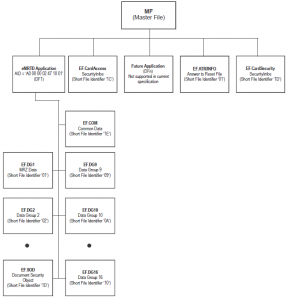Currently in context of ePassports ICAO LDS 2.0 is a hot topic. Today I would like to tell you some interesting details about an interim version, called LDS 1.8. The Logical Data Structure (LDS) specifies the way to store and protect data on ePassports (eMRTDs). Especially in the context of ePassports, this specification is required for global interoperability. Current eMRTDs are using ICAO LDS 1.7 to organise and store the data. This post describes ICAO LDS 1.8, the difference to LDS 1.7 and the motivation to use this new data structure.
The specification Doc 9303 Part 10 (‘Logical Data Structure (LDS) for Storage of Biometrics and Other Data in the Contactless Integrated Circuit (IC)’) describes all data groups and elementary files used in context of ePassports. The file EF.COM is a kind of directory where all data groups are listed. Additionally, there is a version number encoded that represents the version number of the local data structure and a Unicode Version that is used (typically 4.0.0).
So with the ‘directory’ of the ePassport, an inspection system should be able to read all relevant files of the chip. The procedure to read the information is explained in a previous posting. But addressing the files via EF.COM is risky because EF.COM cannot be trusted. EF.COM is not hashed and not signed and cannot be verified during Passive Authentication. This implies EF.COM can be manipulated easily and the manipulation in turn can be hidden easily. This way an attacker can downgrade a secure chip e.g. with Extended Access Control (EAC) to a simple chip with Basic Access Control (BAC) only by deleting the files in EF.COM. In other words, this way to detect a file on an ePassport is insecure and should be avoided.
By using the command SELECT FILE, one can also detect a file. With this command you can try to select a file in the file system of the chip and if the chip responds positively you might be sure that this file is available. This way involves the problem that some system integrators personalise the chip with empty data groups. So the chip responds positively to a SELECT FILE command, but the file does not really exist. To put it in a nutshell, this way is not sufficient either.
With ICAO LDS 1.8 all information stored in EF.COM has been duplicated now in file EF.SOD. This means that the EF.COM is deprecated and can be removed from the ePassport with the next LDS version after V1.8. By doing this a file can be detected by reading EF.SOD in a secure way. Without the file EF.COM the ePassport will be even more secure.
The following code shows the extension in EF.SOD Version 1.8:
LDSSecurityObject ::= SEQUENCE {
version LDSSecurityObjectVersion,
hashAlgorithm DigestAlgorithmIdentifier,
dataGroupHashValues SEQUENCE SIZE (2..ub-DataGroups) OF
DataGroupHash
ldsVersionInfo LDSVersionInfo OPTIONAL
-- If present, version MUST be V1 }
LDSVersionInfo ::= SEQUENCE {
ldsVersion PRINTABLE STRING
unicodeVersion PRINTABLE STRING }
From a testing perspective a new logical data structure means some more tests. The ICAO test specification for ePassports is already prepared for the data structure, e.g. test suite LDS_D includes some tests for LDS 1.8, whereas the tests for inspection systems are currently missing.
Conclusion: With ICAO LDS 1.8 you can use a way to describe the content of your ePassport in a secure way. This way the insecure file EF.COM can be omitted in the future and the inspection procedure can use secure EF.SOD to get information about the stored data groups.
Update: You can find a discussion concerning LDS 1.8 on LinkedIn here.


Pingback: Update of BSI TR-03105 Part 5.1 available (V1.4) - protocolbench
Pingback: First results of eMRTD Interoperability Test 2016 - protocolbench
Pingback: Update of RF and Protocol Testing Part 4 V2.10 online - protocolbench
Pingback: Update of ICAO RF and Protocol Test Specification - protocolbench
Hi,
the link “You can find a discussion concerning LDS 1.8 on LinkedIn here.” is not working
(thanks for everything you write on this blog, btw, it’s great!!)
Hi Andrea,
thanks for your compliment ;)
LinkedIn reorganized their groups a few days ago. This might cause some trouble with links to discussion. I will try to clarify this…
Cheers,
Holger